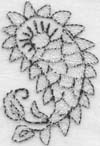Section 15 == *script chart*; *positional chart*; *more help*
15.1 = computer-generated script
If you're a serious student with ambitions to read older texts, wean yourself away from modern computer-generated script as soon as you possibly can. And I mean SOON-- like, preferably as soon as you can read basic words. Start with Narang's reader, not with something computer-generated. Computer-generated script is a poisoned gift.
The reason, of course, is that computer-generated script is so easy to read. Every occurrence of a word is shaped exactly like every other occurrence of that word. Large and reliable spaces are left between words. You learn to read fast, and you come to count on that kind of modern print-world consistency of presentation. But with this kind of reading skill, based on quick recognition of identical computer-generated forms, your time depth hardly goes back much further than the 1990's.
Then when you try to plunge into an older text-- well, you'll think you're not diving but drowning. Words are written with no spaces between them, words are often crammed irregularly into every available cranny for reasons of space and/or esthetics, two or more words are written together, each kātib has his own eccentricities. (And there are other problems discussed in 15.2.)
Whereas if you train yourself on the older material, you can read modern computer-generated script with one hand (eye?) tied behind your back. And you can read all the older good stuff as well, and your computer-script-limited friends will all be jealous.
15.2 = general script reading
problems
When reading older Urdu, a number of problems should be expected. Here are some of the main ones, in no particular order:
== archaic baṛī ye : If you see a letter that looks like a word-final chhoṭī ye with half of its tail cut off, it's really a baṛī ye . In other old texts, chhoṭī ye in its full normal form-- and sometimes even with two dots below it-- routinely replaces final baṛī he .
== kāf for gāf : This irritating conflation appears in some archaic texts, in imitation of Arabic (which has no gāf ). You just have to get used to it.
== conflation of the he forms: The distinction that has come to be made in modern Urdu between the separate letter chhoṭī he and the aspirator do-chashmī he is not observed in older texts.
== conflation of the nūn forms: The distinction that has come to be made at the end of words in modern Urdu between full nūn on the one hand, and nūn-e ġhunnah , or dotless nuun, to show nasalization, is often ignored in older orthography; both forms are written as a full nūn .
== conjoined words: Expect to see words written together, especially in postpositional phrases: keliye and ist̤araḥ and so on.
== punctuation: In general, punctuation is both scanty and casual. The all-purpose " _ " is used haphazardly: sometimes it appears as a clause-divider within a sentence, and sometimes it doesn't appear at the end of a sentence where we would expect it.
== direct discourse: Traditional Urdu almost always prefers direct discourse ("He said, you're a fool") rather than indirect discourse ("He said I was a fool"). This applies even to thoughts and things that people say to themselves. Since quotation marks weren't used, be alert for various possibile readings.
== kih : Whenever a phrase is preceded by the multipurpose little kih , be on the alert for many possibilities, from explanation to quotation and beyond.
== errors of kitābat : Don't beat your brains out over a single word or phrase. If you're misreading it, you may be struggling in vain to figure out something that doesn't exist in the first place. Or the calligrapher (and/or editor) may have made an error. Just mark such occurrences, and contrive to get hold eventually of somebody you can ask for help.
== four overhead dots in a square pattern used as a retroflex marker: This is how the retroflex consonants used to be indicated, before the modern mark that looks like a small t̤oʾe was adopted. For examples, see Platts' Dictionary.
== archaic long vowels: In older usage, is and us were often spelled with long vowels, as īs and ūs ; similarly you might see īdhar and ūdhar , and a few other such cases. Scansion, however, was usually not affected. Sometimes those spellings do signal changes in scansion; Ghalib, for example, uses spelling changes to signal scansion.
== early calligraphic styles:
If you have to read really old texts, you may need major
help, especially for shikastah
and other difficult script styles. Get hold of Reading
Nasta'liq: Persian and Urdu Hands from 1500 to the
Present, by William L. Hanaway and Brian Spooner
(Costa Mesa, California: Mazda Publishers, 1995).
There's nothing like it, and it contains exactly what
you'll need. Or if you really feel tough-minded, try
this 1933 North Indian *handbook
of shikastah* and other difficult script styles.
